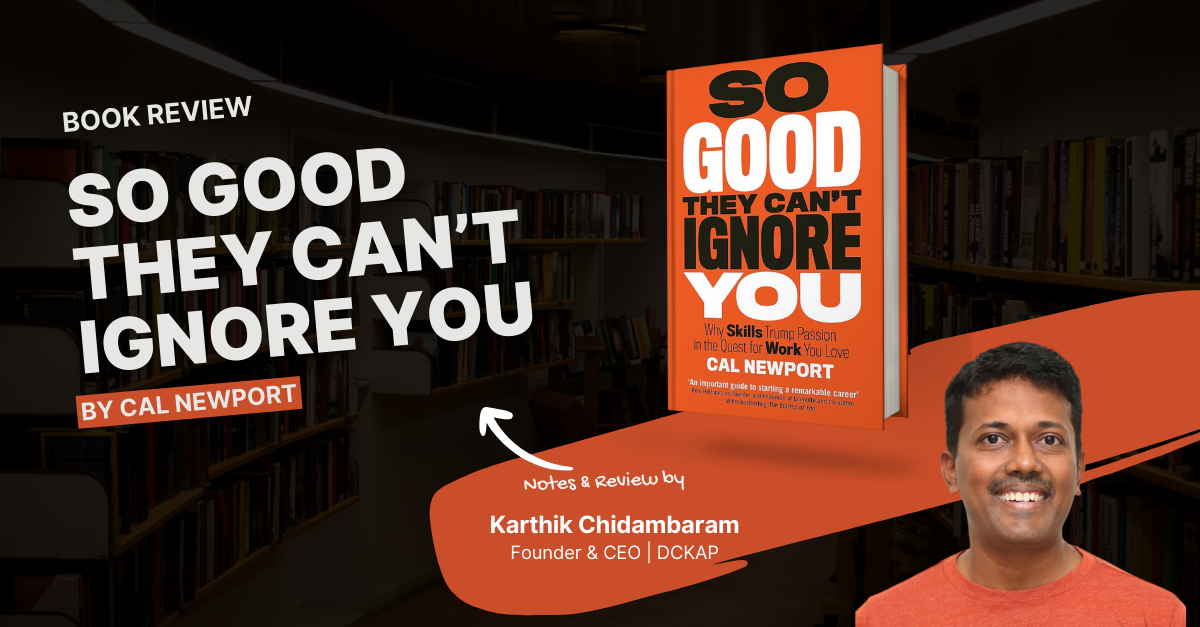So Good They Can’t Ignore You by Cal NewPort
I picked up So Good They Can’t Ignore You by Cal NewPort at the 47th Chennai Book Fair. As I have read Cal Newport’s DeepWork and have heard a few people talk about this book, I decided to give it a read.
The title of this book comes from the 2007 episode where comedian Steve Martin talks about his memoir Born Standing Up. When Rose asks about advice for aspiring performers, how do you get an agent? How do you get your script to be selected? He gave an answer to the question about how to become a famous comedian: “Be so good they can’t ignore you.”
There are no shortcuts to success. Eventually, you become so experienced and then there is a confidence that comes out.
Passion or Skill?
We have often heard people say, follow your passion. However, the author argues that more than passion we need to focus on developing our skills. In our early years (especially as kids or even as we grow up, we will not know what our passion is). The author quotes Steve Jobs’s famous graduation keynote address where he talks about following your passion. However, in order for Steve Jobs to get to that level, he tried different things, took different paths, one thing led to another, and discovered what he was good at. This is the path.
A lot of us work on stretching ourselves to convince the world that we are good at something or that our writing or work is interesting. The author took inspiration from Martin – Not to focus on these little things, to see who is noticing or not. Instead, focus on getting better. The author tracks how he spends time dedicated to thinking hard about research problems. This hour-tracking strategy makes a big difference and is directly related to the quality of work one produces. An obsessive focus on the quality of work. This approach could also be called ‘The Craftsman Mindset’
Career Capital:
Often, we like great, well-paying jobs. If you need something that is rare and valuable, you also need to offer something that is rare and valuable in return. You have to turn your focus to making your skills more rare and valuable. These rare and valuable skills you can offer is ‘Career Capital’. The author writes about two successful career capitalists – Alex Berger (a television writer) and Mike Jackson (a cleantech venture capitalist). They both focussed on getting good, not finding their passion. There is a lot of difficulty in getting good and they went through the difficult. Mike tracks every hour of his day in a spreadsheet down to quarter-hour increments. He says it is so easy to come to work and spend time checking emails. Mike admits that he does not do much email and it is not a part of his core work. Patience is also the key. You can’t expect results immediately, and you need to look into the future. Here is how Steve Martin put it in his interview with Charlie Rose. Steve told himself that if he has been playing for 40 years, anyone who sticks to something for 40 years will be pretty good at it. Steve Martin was willing to look forty years into the future and also willing to wait for the payoff or recognition.
Practice:
As all of us work 8 hours a day, what becomes the key differentiator? Why are some people a lot more successful than others? It is practice. The author also recommends that we deliberately practice every day. When you practice deliberately, you get out of your comfort zone and you may not like it. However, this is what will make the difference. E.g.: An athlete getting up at 4:00 am in the morning, practicing deliberately, or running 10 rounds on the ground. This is a deliberate practice. They stretch and you need to stretch your abilities. The 10-year rule or 10,000 hour rule -, 10 years of practice or playing before attaining international recognition. This is popularized in Malcolm Gladwell’s 2008 best-selling book ‘Outliers’. Bill Gates’ Dad was a fanatic about practicing.
One more key trait is to solicit feedback or criticism on your work so you can get better at what you do. The author also shares an interesting note that Magnus Carlsen paid Gary Kasparov over $700,000 a year to add polish to his chess playing style. By working hard and practicing hard, you become so good that they can’t ignore you. This not only applies to artists or public figures but to each of us in our professional lives.
Taking Control of Your Time:
A job is a calling in a way and the work we do is also an important part of our identity. The more experience we have the better we get. You also need to gain control of what you do. (Gain Control of your time). However in order to do this, you need to be good and also offer something in return. The author also writes about ROWE companies (Results Only Work Environment) where companies do not focus on the time one is logging in, and working, but focus on results. Giving people control over what they do increases their productivity and happiness.
Control Traps:
The author writes about three different types of control traps. The first one is trying to take control of your time without offering much in return (or) not having invested in career capital.The second control trap is that when you have built enough career capital, people around you will resist you from making the change. The third rule is that taking control of your time and doing something should also be financially viable. He provides a simple rule that anything significant we work on should be financially viable. Do what people will be willing to pay for.
How do you create a moment?
The author references Derek Sivers Ted video (3 minutes) on how to create a movement. A leader needs the guts to stand out and be ridiculed. A young man/boy without his shirt starts dancing by himself. Then another guy joins the dance. It is so easy to follow the young man/boy. The first follower is going to show everyone else how to follow. The leader now embraces the follower as an equal. It is not about the leader anymore, it is about them. The first follower is an underestimated form of leadership in itself. The first follower transforms a lone nut into a leader. Then comes the 2nd follower. It is no longer 1 or two people, it is 3 and it is a crowd. A movement must be public. It is not just important to show the leaders, but the followers. New followers emulate the followers, not the leader. 2 more people join and 3 more people join. Now we have momentum, the tipping point, and now we have a movement. As more people join in it is less risky. Folks sitting on the fence have no reason not to join, and they will also join. Eventually, people who do not join the crowd will be ridiculed for not joining in. This is how you create a movement. Nurture your first few followers as equals. It is about the movement and not about you. If you really want to start a movement, have the courage to follow and show others how to follow.
Rule 4 of the book talks about the Mission or purpose of the work we do. Think Small, Act Big. The author writes that before we have a mission and work on it, it is important to have career capital (a rare skill that we are good at). Not having career capital or skill set and working on a mission or working with purpose will not help. The author gives an example of Pardis Sabeti who built her career on a clear and compelling mission (help to cure an ancient disease). We need to be willing to work hard.
In the discovery of sunspots in 1611, four scientists from four different countries all identified the phenomenon during the same year. The first electrical battery was invented twice in the mid-eighteenth century. This is adjacent possible (the spontaneous formation of complex chemical structures from simpler structures). Adjacent possible is the region beyond the current cutting edge. A lot of inventions are done this way. E.g.: The next big ideas in any field are typically found right beyond the current cutting edge in the adjacent space. However, the key is the get to the cutting edge in your field. The author argues that Innovation is more systematic.
In order to get to your mission, you first have to get to the cutting edge (you have to be really good and up your skill sets). This practice of getting to the cutting edge requires a lot of small actions and running various experiments. Little bets are required in order for you to get to your mission. You need to run a lot of little bets and see what works and what doesn’t. For example, in order for you to test if a joke is working or not, you can run it by a small group of audience / at a family gathering and watch people’s reactions. Based on the feedback you can play the joke to a larger audience. This is also a good example of small betts.
The mission also requires marketing. Instead of you just working on the mission you got to get others inspired to work on it together. In order for this to work on, the work you are doing needs to be remarkable and cannot be just another thing. E.g Giles Bowkett, who leveraged open source to bring together art and ruby programming. He came up with Archaeopteryx, an AI-driven music creator. Seth Godin says that you either have to be remarkable or invisible. He wrote a book ‘Purple Cow’ – one that would stand out. Remarkable marketing is the art of building things worth noticing. Remarkable projects compel people to share the word and they share it. For a mission-driven project to be successful, it should be remarkable in two ways 1. It must compel people who encounter it to talk about it to others and 2. It should be launched in a venue that supports remarking.
Towards the end of the book, the author describes how he applied the four rules in his own life.
Books Referenced:
This is popularized in Malcolm Gladwell’s 2008 best-selling book ‘Outliers’
The Tipping Point
Little Bets, Peter Sums
Purple Cow- Seth Godon
Where good ideas come from – Steven Johnson
My Take on the book:
Thanks, Cal for writing this book. It was a great read. Some of my big learnings were, it is not just about passion, it is about getting good at what you do and defining your mission. Deliberate practice (working hard and doing things you are not comfortable with). It will be painful, however it is what will give you the desired results. Taking Control of your time. Dedicate time to do deep thinking (track the time spent on a daily basis doing deep thinking), taking little bets, and standing differentiated. I also enjoyed the Derek Sivers video on How to create a movement. You give practical tips that we can apply in our everyday lives as a knowledge worker or otherwise. A great read.




Leave a Reply